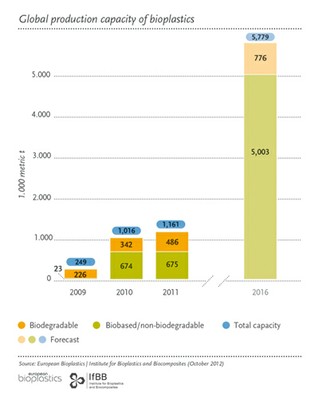 European Bioplastics have revealed that the market for biobased plastics in 2011 was around 1.2 million tonnes but the rapid scale of development in this area could see the market grow to nearly 6 million tonnes by 2016; exceeding previous expectations.
European Bioplastics have revealed that the market for biobased plastics in 2011 was around 1.2 million tonnes but the rapid scale of development in this area could see the market grow to nearly 6 million tonnes by 2016; exceeding previous expectations.
The composition of the market is also changing and by far the strongest area of growth will be non-biodegradable bioplastics, especially so-called ‘drop-in’ solutions like biobased polyethylene (PE) and polyethylene terephthalate (PET). These ‘drop-in’ solutions are identical to their conventional fossil-based counterparts but are made from renewable raw materials.
Partially biobased PET already accounts for 40 per cent of global bioplastics capacity and could increase to nearly 80 per cent (or 4.6 million tonnes) by 2016. This growth is being driven by demand from brands like Coca-Cola. Coca-Cola have invested millions in developing their trademarked PlantBottle®, which is made of up to 30 per cent plant-based PET and to do date the company has sold more than 2.5 million PlantBottle’s worldwide.
Coca-Cola also hope to move away from using food crops in the production of their PlantBottle and are exploring alternatives, such as wastes and agricultural residues, as they look to roll out 100 per cent biobased bottles in the future.
Other brands are also developing packaging made from non-food crops and residues and earlier this year Pepsi developed the world’s first 100 per cent biobased PET bottle, which is made from materials such as switch grass, pine bark and corn husks. In the future, the company expect to broaden the renewable materials used to create the “green” bottles to include orange peels, potato peels, oat hulls and other agricultural byproducts from its foods business.
But it is not only the non-biodegradable plastics market that is growing, the biodegradable market is also demonstrating impressive growth rates, with production capacity predicted to increase by two-thirds between 2011 and 2016.
Leading contributors to this growth will be polylactic acid (PLA) and polyhydroxyalkanoates (PHA), with each market predicted to grow to 298,000 tonnes (+60 per cent) and 142,000 tonnes (+700 per cent) by 2016, respectively.
“The enormous growth makes allowance for the constantly increasing demand for sustainable solutions in the plastics market. Eventually, bioplastics have achieved an established position in numerous application areas, from the packaging market to the electronics sector and the automotive industry”, says Hasso von Pogrell, Managing Director of European Bioplastics.
European Bioplastics do however warn that there is a disturbing trend in the geographic distribution of production capacities. Europe and North America remain interesting as locations for research and development and also important as sales markets. However, establishment of new production capacities is favoured in South America and Asia.
“European Bioplastics invites European policy makers to convert their declared interest into concrete measures. We are seeing many general supportive statements at EU level and in the Member States”, says Andy Sweetman, Chairman of European Bioplastics.
“There is, however, a lack of concrete measures. If Europe wants to profit from growth at all levels of the value chain in our industry, it is high time the corresponding decisions are made.”
For a more in-depth impression of the world of bioplastics, visit the 7th European Bioplastics Conference on 6 and 7 November in Berlin. Dr John Williams, Head of Materials at NNFCC, will be speaking at the event along with other leading experts in the field of bioplastics.
Source
NNFCC, 2012-10-12.
Supplier
Coca-Cola Co.
European Bioplastics e.V.
NNFCC
PepsiCo
Share
Renewable Carbon News – Daily Newsletter
Subscribe to our daily email newsletter – the world's leading newsletter on renewable materials and chemicals










